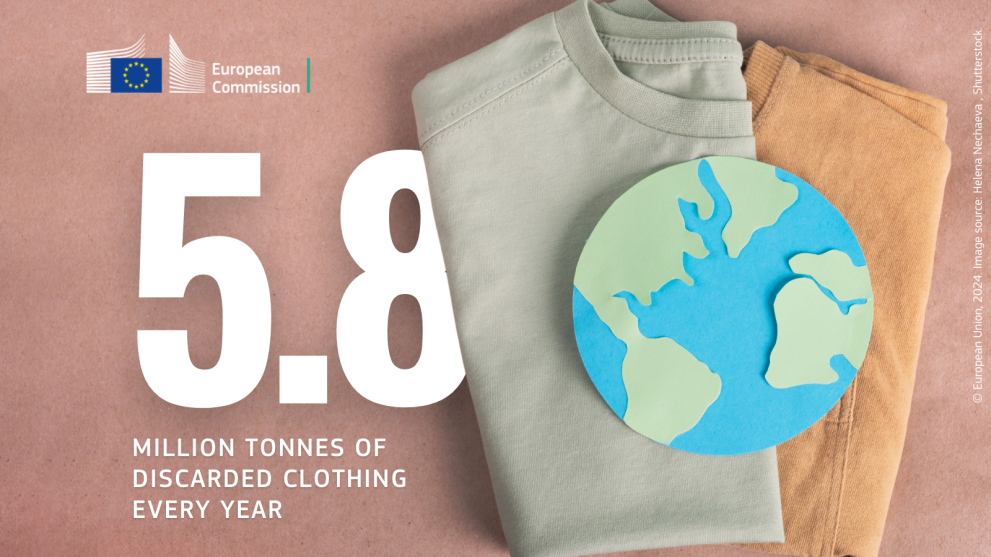
The common habit of using clothes for shorter periods of time before discarding them contributes most to unsustainable patterns of overproduction and overconsumption. These kinds of trends are commonly referred to as fast fashion, encouraging people to continue purchasing cheap, low-quality clothing that is made quickly to follow the latest styles.
As a result, more than 5.8 million tonnes of clothing are discarded in the EU every year, around 11.3 kg per person. Only 1% of this dumped material is recycled into new clothing and remaining textile is dumped on a landfill in Europe or is exported to Africa and Asia, as reported by the European Environment Agency.
Complementing the Waste Shipment Regulation, the recent EU Strategy for Sustainable and Circular Textiles addresses the production and use of textiles, while acknowledging the significance of the textile industry. It carries out the commitments made in the European Green Deal, the Circular Economy Action Plan, and the European Industrial Strategy.
In addition, Horizon Europe projects are paving its way to develop innovative solutions to make the fashion industry more sustainable and just. This means creating clothing in an eco-friendly way by reusing and recycling it wherever feasible as well as guaranteeing that human rights are respected in all steps of the production chain. Find a selection of these projects below and learn more about sustainable practices in the textile sector.
Textile waste transformation into new fibres
The New Cotton project is taking post-consumer textile waste and regenerating it back into a brand-new textile ‘superfibre’ that goes by the name Infinna™ using cellulose carbamate technology. The technology can process cotton-rich textile waste, including mixed fibres, and other cellulose-based waste feedstocks into new fibres and textiles. With a growing awareness of the adverse effects of non-recyclable fibre, major fashion brands like Adidas and H&M are now incorporating Infinna™ into their retail garment production. The project aspires to make circularity the new norm in the fashion industry.
Enhancing circularity and sustainability in European textiles, the CISUTAC project focuses on polyester, cotton, and cellulosic fibers and targets three interesting sub-sectors: garments, active goods, and workwear. CISUTAC will establish sustainable, inclusive and large-scale value chains for material reuse, repair, and recycling. Through three pilot initiatives (repair and disassembly, sorting for reuse and recycling, and circular garments via fibre-to-fibre recycling), the project aims to demonstrate feasibility and showcase positive impacts on the environment, the textile sector and consumers.
Just transition to a circular fashion industry
The FReSCH project is an impressive action-research initiative focused on sustainability and social justice in fashion supply chains. The project’s researchers collaborated with a fashion giant’s manufacturers in Turkey to examine economic, environmental and social sustainability to understand the trade-offs, tensions and outcomes in the transition to a more viable model. In addition to various academic articles and media contributions, FReSCH has been actively engaged with policy making, contributing to a public consultation on the EU Strategy for Sustainable Textiles.
The project is not alone in its efforts to transform the fashion industry into one that ensures human rights protection. Recently, the EU adopted a proposal on Directive on corporate sustainability due diligence that will push major industries toward more ethical, fair, and environmentally-friendly business practices.
A new type of eco-friendly leather
Introducing a new way to substitute leather; fish skins. This eco-friendly material, which is durable, odour-free and stronger than cow leather, is a big catch for the fashion industry. The EU-funded FISHSkin project developed this new category of raw material, bringing together mariculture and the fashion industry. In particular, it turned fish meat and skin—which are frequently wasted—into usable and profitable items. The project studied the viability of fish leather in the fashion industry and developed new techniques and methodologies for a market take-up at industrial level.
A dual force for sustainable fashion
Europe's commitment to fund circular economy research and innovation is a beacon of hope for the fashion industry. By prioritizing ethical practices, embracing circular economy principles, and fostering innovation, Europe is setting an example for the global fashion community.
In addition, the power to redefine the narrative lies in the hands of every individual consumer. As guardians of our choices, we hold the key to transforming the fashion landscape into one that prioritises sustainability and paves the way to an industry that respects both people and the planet.
Further information
For updates on the world of innovative research— follow REA on LinkedIn and X accounts @REA_research and @EUgreenresearch. You will get up-to-date information about the EU-funded projects, their findings as well as the upcoming events.
Details
- Publication date
- 26 February 2024
- Author
- European Research Executive Agency
